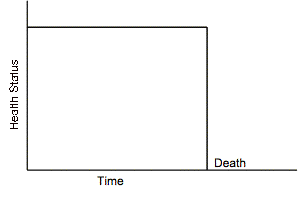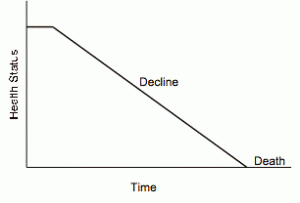Glaser and Strauss first described the concept of death trajectories in their pioneering qualitative research in the 1960’s. They noted that the temporal pattern of the disease process leading to a patient’s death had profound impacts on the experience for patients, families and clinicians. Figures 1-3 visualize three simplified examples of common trajectories towards death. Recognizing such disease trajectories assists physicians in using prognostication to care for seriously ill patients.
Figure 1 represents sudden death without prior warning. Death related to trauma such as a motor vehicle accident is a common example.
Trajectory 1: Sudden death
- sudden death from trauma, such as a motor vehicle accident
- Acute MI or Fatal Arrhythmia
- Massive Stroke or MI
Figure 2 illustrates a steady decline in health status over time with an inevitable slide towards death. The steepness of this slope varies according to the chronic illness. Several types of cancer (pancreatic, lung, stomach) are classic examples of this trajectory. Usually the time pattern from diagnosis to death is measured in weeks to months. Given the predictability of such decline in these cancers, recognition that the end-of-life is nearing is easier and referral to hospice easier. When the Medicare Hospice benefit was first implemented the vast majority of patients served had cancer diagnoses. Other chronic illnesses fit this pattern but have varying time slopes. Alzheimer’s type dementia follows this pattern but on average from diagnosis to death takes place over years rather than months or weeks.
Trajectory 2: Steady decline with expected death no matter what treatments offered
- Poor prognosis cancers
- Pancreatic (weeks to months)
- Lung (weeks to months)
- Metastatic Colon (weeks to months)
- Neuro-degenerative diseases
- Dementia Alzheimer’s Type (years)
- Dementia Vascular (years)
- Parkinson’s disease (years)
- Amyotropic Lateral Sclerosis (months to year)
Figure 3 represents chronic illnesses with a gradually declining slope and episodes of acute crises. After each acute crisis the patient’s baseline drops even further. Chronic lung disease, congestive heart failure and end stage liver disease are examples of this pattern. It is difficult to predict which crisis will end in the patient’s death. After surviving several crises it is often difficult for the patient and family to believe they won’t survive the next one. And from the clinician’s perspective it is difficult to not offer treatment when she/he can’t be certain the patient won’t benefit. Initially few patients with such a pattern were admitted to hospice. In 2000 10% of hospice patients had a primary diagnosis of end stage heart disease, 6% end stage lung disease and 2% end stage liver disease.
There are several chronic illnesses with a gradually declining slope and episodes of acute crises in which sudden, “unexpected” death can occur. One example is congestive heart failure. Of patients with a cardiac ejection fraction of less than 20% a significant proportion (15-40%) will die of a cardiac arrhythmia or MI over the span of a year without an implanted defibrillator/pacemaker. From the perspective of the patient and family, if they are unaware of this risk, death is sudden and without warning. Another example is a patient who has had an ischemic stroke and recovered. Such patients have a significant likelihood of dying suddenly from a massive stroke or heart attack. When the patient and family are unaware of this possibility, if sudden death occurs it will be perceived as occurring without warning.
Trajectory 3: Steady decline with intermittent crises and unpredictable death point
- Advanced Stage Heart Disease (months to years)
- Advanced Stage Lung Disease (years)
The concept of death trajectory is helpful in sharing with patients and families what they can expect in the future. It gives all of us: patient, family and clinician, a common context for anticipating potential challenges and how we might plan for them. Each pattern offers a unique set of opportunities and challenges. For example consider trajectory 3 in a patient with far advanced congestive heart failure. If you don’t inform the patient and family of the significant possibility of sudden death, then you have limited their opportunity to prepare for that event. The ramifications medically, economically, emotionally and spiritually can be enormous. Alternatively knowing that same patient has survived several previous crises with CHF assists you in understanding why the patient and family are so certain that they will survive the next crisis as well.


